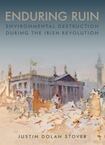
What did Dublin city taste, smell and sound like during the 1916 Rising? How did Irish weather influence fighting during the War of Independence? How many men did it take in 1921 to dig a crater in rural Cork to foil the enemy? How many buildings were destroyed during the upheavals of 1916-23?
This first book by Idaho-based historian Justin Dolan Stover, who completed his PhD on the Irish Revolution in Trinity College Dublin, poses and answers a number of such questions, making his history of environmental destruction an absorbing and highly original contribution to the library of Ireland’s revolutionary decade. He assesses how a range of different spaces were transformed by violence, how environments were manipulated, and the physical ruin that resulted. In one sense, this book is about highlighting “evidence hidden in plain sight” but that research challenge involved detailed sampling to uncover 2,183 instances of environmental manipulation and ensuing damage to the built and natural environment from January 1919 to July 1921.
The increasing militarisation of civilian spaces is one of the book’s main themes, which also allows for the documenting of a “sensory history” of the period; the scenes, sounds and smells that resulted from burning concrete, oil and timber. There was also much smashing, boring, burrowing and trenching, often on a small scale. In tandem, the sabotaging of bridges (there were two and half thousand rail bridges spanning Ireland’s 1,500 miles of navigable waterways in 1921) and roads, along with tree-felling, were seen as vital enterprises in the quest to make Ireland ungovernable. These tasks involved hard labour; it took 60 men from two IRA companies to move 1,200 cubic feet of earth to open a large trench at Boherash Cross in Cork in 1921.
The IRA essentially “enlisted the land as a native 5th column in the guerrilla war”. The increasing frustration of Crown forces led to even more assaults on urban and rural areas and scenes and reports of destruction were continually used in the propaganda war as Irish republicans, invoking public memory of the rubble of the first World War, communicated “its political and environmental victimhood to international audiences”.
READ MORE
Dolan Stover cleverly employs a range of sources, including papers from the Imperial War Museum, IRA intelligence reports, personal testimony from veterans, criminal injury books and compensation and pension claim files to capture both the physical carnage and those at the centre of it as both perpetrators and victims, never losing sight of the human impact.
During the 1916 Rising, human and animal bodies rotted where they fell; the odours of death lingered as extraordinary efforts were made by the Dublin fire brigade to deal with what Dublin City Council later identified as 240 properties destroyed by fire.
Ireland’s militarised geography was greatly expanded in subsequent years as drilling, preparing landscapes for ambush, transporting gelignite and attacking and burning RIC stations became commonplace. Between April 3rd and 4th, 1920, alone, over 200 RIC barracks were targeted, partly because the IRA had access to incendiary chemicals. UCC student Michael O’Donoghue lectured IRA volunteers on engineering demolition, while arsenic was found in the intestinal tracts of horses used by the RIC.
Valuable insight is also provided in relation to the British perspective; the “Crown Forces came to lament the Irish environment”, the pitiful state of the roads and the extreme weather fluctuations. The winter of 1920 was exceptionally cold and wet, and while those conditions did not stymie guerrilla activity in a significant way, the impact it had on the physical wellbeing of Cumann na mBan and IRA volunteers due to exposure was significant.
[ Violence of 1923 extinguished the idealism of a nascent StateOpens in new window ]
By May 1920 Crown Forces had damaged approximately 90 Irish towns in reprisals and as a result, thousands lost “livelihoods, prospects and securities”. In January 1920 the main street of Thurles was wrecked, and later that year the mayor of Limerick Michael O’Callaghan told the commander of the British Forces in Ireland, Nevil Maccready, of “the smouldering ruins of once prosperous business houses before my eyes”. There were also about 155 house-raids daily in Ireland in 1920, and those often-violent visitations generated long-term trauma. During the sack of Balbriggan in September 1920, 50 properties were destroyed, just over half of them private homes, with some victims having to flee barefoot, while the subsequent burning of Cork city put 2,000 out of work.
[ The Irish Civil War part 1: scale of the onrushing tragedy powerfully conveyedOpens in new window ]
[ The Irish Civil War part 2: into the grisly heart of brother killing brotherOpens in new window ]
Pairing Ireland with wartime Belgium or France (“Balbriggan the Irish Louvain”) kept the propagandists busy and was effective; the American Committee for Relief in Ireland visited 100 damaged towns in Ireland in 1921, part of a wider internationalising of the Irish conflict that included “Great War hyperboles”. Although this book is largely concerned with the 1916-21 period, there was more destruction to follow with the Civil War. Ernie O’Malley’s description of the destruction of the Four Courts in 1922 as involving “duelling orchestras of crashing stone and singing flame” was poetic, but this book does justice to the range of environmental destruction behind such lyricism.
Diarmaid Ferriter is Professor of Modern Irish History at UCD. His book Between Two Hells: The Irish Civil War (Profile Books) is now available in paperback
















